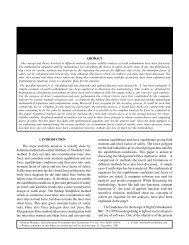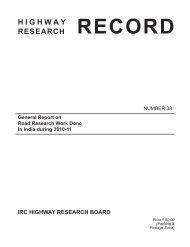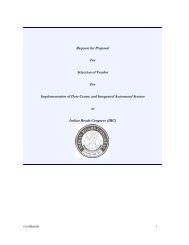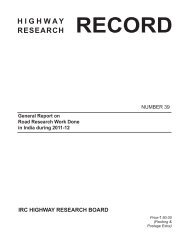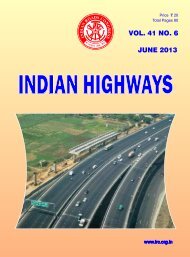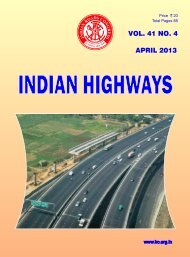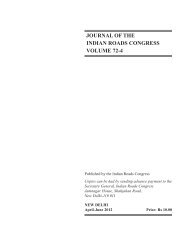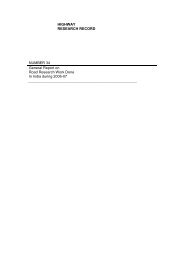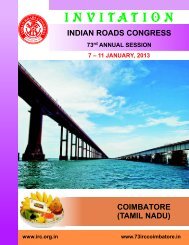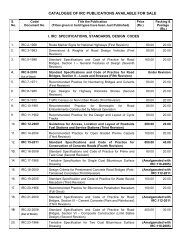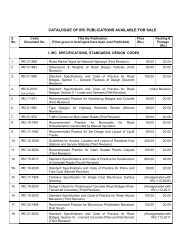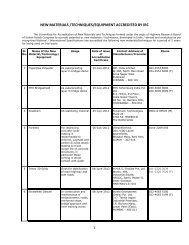A Review of Highway Agencies in the South Asia Region
A Review of Highway Agencies in the South Asia Region
A Review of Highway Agencies in the South Asia Region
You also want an ePaper? Increase the reach of your titles
YUMPU automatically turns print PDFs into web optimized ePapers that Google loves.
A <strong>Review</strong> <strong>of</strong> <strong>Highway</strong> <strong>Agencies</strong> <strong>in</strong> <strong>the</strong> <strong>South</strong> <strong>Asia</strong> <strong>Region</strong><br />
REFORM<br />
Economist explicitly<br />
<strong>in</strong>volved <strong>in</strong> plann<strong>in</strong>g<br />
and development<br />
Some nontechnical (and nontraditional) competencies could be located <strong>in</strong> <strong>the</strong> national<br />
road agencies <strong>in</strong> <strong>the</strong> region and <strong>in</strong> <strong>the</strong> Road Development Corporation/Boards established<br />
<strong>in</strong> India. However, <strong>the</strong> quality <strong>of</strong> skills needs to be enhanced; for example, only 30 percent<br />
<strong>of</strong> <strong>the</strong> highway agencies are able to provide safety statistics for <strong>the</strong> road network because<br />
safety is not a core competence <strong>of</strong> <strong>the</strong> agencies, nor is it considered <strong>the</strong>ir responsibility<br />
or concern. In addition, only 40 percent <strong>of</strong> <strong>the</strong> highway agencies have a safety council or<br />
committee <strong>in</strong> place, evidence <strong>of</strong> <strong>the</strong> fact that safety is not on <strong>the</strong> list <strong>of</strong> priorities for most<br />
highway agencies.<br />
The structure <strong>of</strong> highway agencies <strong>in</strong> <strong>South</strong> <strong>Asia</strong> is based on <strong>the</strong> functions carried out<br />
by <strong>the</strong>m. Some highway agencies have restructured <strong>the</strong>mselves along functional l<strong>in</strong>es,<br />
but structures based on territorial/regional jurisdictions still cont<strong>in</strong>ue <strong>in</strong> many cases and<br />
sometimes coexist with functional arrangements <strong>in</strong> <strong>the</strong> headquarters. Some highway<br />
agencies have also set up regional branches for <strong>the</strong> execution <strong>of</strong> construction works. The<br />
creation <strong>of</strong> a separate, dedicated organization or department to deal with large projects<br />
is also not uncommon – particularly <strong>in</strong> those agencies that receive external multilateral<br />
fund<strong>in</strong>g for <strong>the</strong> development <strong>of</strong> highway networks. Most highway agencies have now<br />
established quality management/control units and a few have set up specialist cells for<br />
plann<strong>in</strong>g and asset management, road safety management, social and environment<br />
aspects, and so on. However, <strong>the</strong> terms <strong>of</strong> reference <strong>of</strong> <strong>the</strong>se specialist cells are usually not<br />
very well def<strong>in</strong>ed and <strong>the</strong>y fail to attract staff with relevant skills. Among <strong>the</strong> national road<br />
agencies, Bangladesh provides an exception <strong>in</strong> <strong>the</strong> region, where <strong>the</strong> road agency structure<br />
<strong>in</strong>cludes a Plann<strong>in</strong>g and Development cell, headed by an economist, responsible for <strong>the</strong><br />
prioritization <strong>of</strong> road projects accord<strong>in</strong>g to economic need.<br />
The RDCs have a slightly different management structure. They are formed as corporate<br />
entities under <strong>the</strong> relevant companies/corporate act and governed by a board consist<strong>in</strong>g <strong>of</strong><br />
majority representation from <strong>the</strong> government and limited representation from road users/<br />
private sector. Most organizations have been created as an implementation arm <strong>of</strong> <strong>the</strong> PWD<br />
to promote PPP contracts. They also enjoy more <strong>in</strong>dependence <strong>in</strong> decision mak<strong>in</strong>g and, at<br />
times, are able to raise resources from <strong>the</strong> market. Although <strong>the</strong>ir overall mandate is limited<br />
<strong>in</strong> comparison with <strong>the</strong> regular road authorities, <strong>the</strong>ir corporate structure provides <strong>the</strong>m <strong>the</strong><br />
leverage <strong>of</strong> faster implementation and expeditious decision-mak<strong>in</strong>g capability.<br />
In all cases, powers are delegated from <strong>the</strong> most senior <strong>of</strong>ficial to subord<strong>in</strong>ate <strong>of</strong>ficials.<br />
The extent <strong>of</strong> delegation varies across organizations. Delegation <strong>of</strong> powers is categorized<br />
by nature (approval <strong>of</strong> proposals, time extensions, cost overruns, and so on) and size, for<br />
example, m<strong>in</strong>or cost or time overruns can be approved by junior <strong>of</strong>ficials. For <strong>in</strong>stance, <strong>in</strong><br />
<strong>the</strong> case <strong>of</strong> Pakistan, powers are (<strong>of</strong>ficially) not delegated to a level lower than <strong>the</strong> head <strong>of</strong><br />
department.<br />
Bangladesh<br />
The Bangladesh RHD has a clearly def<strong>in</strong>ed structure (Figure 2.12): Five Additional Chief<br />
Eng<strong>in</strong>eers head <strong>the</strong> different departments <strong>of</strong> <strong>the</strong> RHD and report to a Chief Eng<strong>in</strong>eer,<br />
who is <strong>the</strong> highest-rank<strong>in</strong>g <strong>of</strong>ficial <strong>of</strong> <strong>the</strong> RHD. In addition, <strong>the</strong>re are n<strong>in</strong>e Additional<br />
Chief Eng<strong>in</strong>eers; one <strong>in</strong> each zone and four or five Additional Chief Eng<strong>in</strong>eers who work<br />
as Project Directors <strong>of</strong> Development Projects. The Chief Eng<strong>in</strong>eer is appo<strong>in</strong>ted by <strong>the</strong><br />
m<strong>in</strong>istry, to which he also reports. The departments <strong>of</strong> RHD are aligned to functions, for<br />
example, plann<strong>in</strong>g and development, and bridges as well as geographic zones. There are no<br />
departments cater<strong>in</strong>g specifically to projects funded by <strong>in</strong>ternational f<strong>in</strong>ancial <strong>in</strong>stitutions<br />
(IFIs) or donor agencies.<br />
India<br />
In India, many states have PWDs headed by a (Pr<strong>in</strong>cipal) Secretary, a bureaucrat from<br />
<strong>the</strong> adm<strong>in</strong>istrative services and/or an Eng<strong>in</strong>eer-<strong>in</strong>-Chief from <strong>the</strong> department itself, ris<strong>in</strong>g<br />
through <strong>the</strong> ranks. There are <strong>in</strong>stances where <strong>the</strong> technical head, that is, <strong>the</strong> Eng<strong>in</strong>eer-<br />
37



